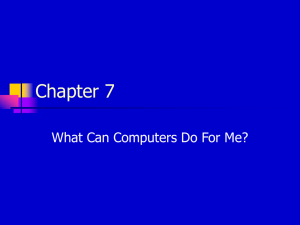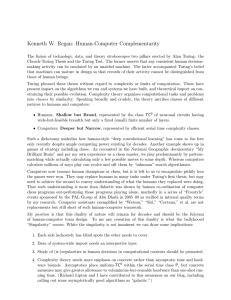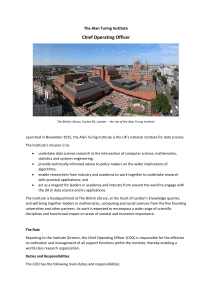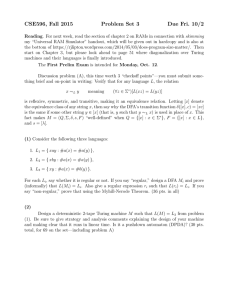Turing Machines Lecture 19 COT 4420 Theory of Computation
advertisement
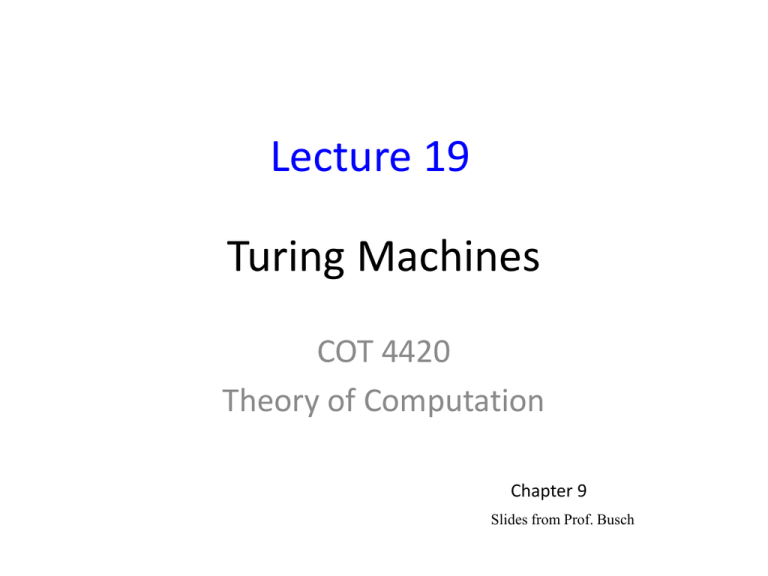
Lecture 19
Turing Machines
COT 4420
Theory of Computation
Chapter 9
Slides from Prof. Busch
Tape
......
A Turing Machine
......
Read-Write head
Control Unit
The Tape
No boundaries -- infinite length
......
......
Read-Write head
The head moves Left or Right
......
......
Read-Write head
The head at each transition:
1. Reads a symbol
2. Writes a symbol
3. Moves Left or Right
The Input String
Input string
......
☐ ☐
a b a c
Blank symbol
☐ ☐ ☐
head
Head starts at the leftmost position
of the input string
......
States & Transitions
Read
q1
Write
a → b, L
Move Left
q2
Move Right
q1
a → b, R
q2
......
☐ ☐
a b a c
☐ ☐ ☐
......
☐ ☐ ☐
......
q1
......
☐ ☐
a b b c
q2
q1
a → b, R
q2
......
☐ ☐
a b a c
☐ ☐ ☐
......
☐ ☐ ☐
......
q1
......
☐ ☐
a b b c
q2
q1
a → b, L
q2
......
☐ ☐
a b a c
☐ ☐ ☐
......
q1
......
☐ ☐
a b a c g
☐ ☐
q2
q1
☐ g, R
q2
......
Formal Definition of Turing Machine
M = <Q, Σ, Γ, δ, q0, ☐, F>
•
•
•
•
•
•
•
Q: a finite set of internal states
Σ: is the input alphabet ( Σ ⊆ Γ-{☐} )
Γ: finite set of symbols called the tape alphabet
δ: transition function (Q × Γ Q × Γ × {L, R} )
q0: the initial state (q0 ∈ Q)
☐: is a special symbol called blank (☐ ∈ Γ)
F: a set of final/accepting states (F ⊆ Q)
Transition Function
q1
a → b, R
q2
δ (q1, a ) = (q2 , b, R)
Determinism
• Turing Machines are deterministic
Not Allowed
Allowed
a → b, R
q2
a → b, R
q2
a → d, L
q3
q1
q1
b → d, L
q3
• No lambda transitions allowed
• It is okay to not have transitions for some alphabet
Halting
The machine halts in a state if there is
no transition to follow
Halting Example 1:
......
☐ ☐
a b b c
☐ ☐ ☐
......
q1
q1
No transition from q1
HALT!!!
Halting Example 2:
......
☐ ☐
a b b c
☐ ☐ ☐
......
q1
a → b, R
q2
b → d, L
q3
q1
No possible transition
From q1 and symbol c
HALT!!!
Accept/Final States
q1
q2
Allowed
q1
q2
Not Allowed
•Accepting states have no outgoing transitions
•The machine halts and accepts
Acceptance
Accept Input
string
If machine halts
in a final state
Reject Input
string
If machine halts
in a non-final state
or
If machine enters
an infinite loop
Observation:
In order to accept an input string,
it is not necessary to scan all the
symbols in the string
Turing Machine Example
Input alphabet {a}
Accepts the language: a*
a → a, R
q0
☐☐,L
q1
☐ ☐
a a a
☐ ☐ ☐
q0
a → a, R
q0
☐☐,L
q1
☐ ☐
a a a
☐ ☐ ☐
q0
a → a, R
q0
☐☐,L
q1
☐ ☐
a a a
☐ ☐ ☐
q0
a → a, R
q0
☐☐,L
q1
☐ ☐
a a a
☐ ☐ ☐
q0
a → a, R
q0
☐☐,L
q1
☐ ☐
☐ ☐ ☐
a a a
q1
a → a, R
q0
Halt & Accept
☐☐,L
q1
Rejection Example
☐ ☐
a b a
☐ ☐ ☐
q0
a → a, R
q0
☐☐,L
q1
☐ ☐
a b a
☐ ☐ ☐
q0
No possible Transition
Halt & Reject
a → a, R
q0
☐☐,L
q1
Infinite Loop Example
A Turing machine for language
a * +b( a + b) *
b → b, L
a → a, R
q0 ☐☐,L
q1
☐ ☐
a b a
☐ ☐ ☐
q0
b → b, L
a → a, R
q0 ☐☐,L
q1
☐ ☐
a b a
☐ ☐ ☐
q0
b → b, L
a → a, R
q0 ☐☐,L
q1
☐ ☐
a b a
☐ ☐ ☐
q0
b → b, L
a → a, R
q0 ☐☐,L
q1
Because of the infinite loop:
• The accepting state cannot be reached
• The machine never halts
• The input string is rejected
Turing Machine Example
Turing machine for the language
y → y, R
q4
☐☐,L
q3
y → y, R
q0
y → y, R
a → a, R
a → x, R
q1
n n
{a b }
y → y, L
a → a, L
b → y, L
x → x, R
q2
☐
a a b b
☐
q0
y → y, R
q4
☐☐,L
q3
y → y, R
q0
y → y, R
a → a, R
a → x, R
q1
y → y, L
a → a, L
b → y, L
x → x, R
q2
☐
x a b b
☐
q1
y → y, R
q4
☐☐,L
q3
y → y, R
q0
y → y, R
a → a, R
a → x, R
q1
y → y, L
a → a, L
b → y, L
x → x, R
q2
☐
x a b b
☐
q1
y → y, R
q4
☐☐,L
q3
y → y, R
q0
y → y, R
a → a, R
a → x, R
q1
y → y, L
a → a, L
b → y, L
x → x, R
q2
☐
x a y b
☐
q2
y → y, R
q4
☐☐,L
q3
y → y, R
q0
y → y, R
a → a, R
a → x, R
q1
y → y, L
a → a, L
b → y, L
x → x, R
q2
☐
x a y b
☐
q2
y → y, R
q4
☐☐,L
q3
y → y, R
q0
y → y, R
a → a, R
a → x, R
q1
y → y, L
a → a, L
b → y, L
x → x, R
q2
☐
x a y b
☐
q0
y → y, R
q4
☐☐,L
q3
y → y, R
q0
y → y, R
a → a, R
a → x, R
q1
y → y, L
a → a, L
b → y, L
x → x, R
q2
☐
x x y b
☐
q1
y → y, R
q4
☐☐,L
q3
y → y, R
q0
y → y, R
a → a, R
a → x, R
q1
y → y, L
a → a, L
b → y, L
x → x, R
q2
☐
x x y b
☐
q1
y → y, R
q4
☐☐,L
q3
y → y, R
q0
y → y, R
a → a, R
a → x, R
q1
y → y, L
a → a, L
b → y, L
x → x, R
q2
☐
x x y y
☐
q2
y → y, R
q4
☐☐,L
q3
y → y, R
q0
y → y, R
a → a, R
a → x, R
q1
y → y, L
a → a, L
b → y, L
x → x, R
q2
☐
x x y y
☐
q2
y → y, R
q4
☐☐,L
q3
y → y, R
q0
y → y, R
a → a, R
a → x, R
q1
y → y, L
a → a, L
b → y, L
x → x, R
q2
☐
x x y y
☐
q0
y → y, R
q4
☐☐,L
q3
y → y, R
q0
y → y, R
a → a, R
a → x, R
q1
y → y, L
a → a, L
b → y, L
x → x, R
q2
☐
x x y y
☐
q3
y → y, R
q4
☐☐,L
q3
y → y, R
q0
y → y, R
a → a, R
a → x, R
q1
y → y, L
a → a, L
b → y, L
x → x, R
q2
☐
x x y y
☐
q3
y → y, R
q3
q4
☐☐,L
y → y, R
q0
y → y, R
a → a, R
a → x, R
q1
y → y, L
a → a, L
b → y, L
x → x, R
q2
☐
x x y y
☐
q4
Halt & Accept
y → y, R
q4
☐☐,L
q3
y → y, R
q0
y → y, R
a → a, R
a → x, R
q1
y → y, L
a → a, L
b → y, L
x → x, R
q2
Observation:
If we modify the
machine for the language
we can easily construct
a machine for the language
n n
{a b }
n n n
{a b c }
Instantaneous Description
Configuration
☐
c a b a
☐
q1
Instantaneous description:
ca q1 ba
☐
x a y b
☐
☐
x a y b
q0
q2
A Move:
q2 xayb ⊢ x q0 ayb
☐
Time 4
☐
Time 5
x a y b
☐
x a y b
☐
q0
q2
Time 6
☐
☐
Time 7
x x y b
☐
☐
x x y b
q1
q1
A computation
q2 xayb ⊢ x q0 ayb ⊢ xx q1 yb ⊢ xxy q1 b
☐
q2 xayb ⊢ x q0 ayb ⊢ xx q1 yb ⊢ xxy q1 b
Equivalent notation:
*
q2 xayb ⊢
xxy q1 b
The Accepted Language
For any Turing Machine M, the language accepted
by M is
L(M) = { w ∈ Σ+ : q0w ⊢ x1 qf x2 for some qf ∈ F,
x1, x2 ∈ Γ*}
If a language L is accepted by a Turing
machine M then we say that L is:
Turing Recognizable
Other names used:
•Turing Acceptable
•Recursively Enumerable
Computing Functions
with
Turing Machines
Definition:
f
A function
is computable if
there is a Turing Machine M such that:
Initial configuration
w
☐
☐
Final configuration
f (w)
☐
qf
q0
For all
w∈ D Domain
☐
In other words:
f
A function
is computable if
there is a Turing Machine M such that:
*
q 0w ⊢
Initial
Configuration
For all
qf f(w)
Final
Configuration
w∈ D Domain
Example
Design a Turing machine that computes:
f ( x, y ) = x + y
• How to represent x and y on the tape?
For simplicity we will use unary notation
For example: x = 5
11111
x
Start
☐
1 1
y
1 0 1 1
☐
q0
initial state
The 0 is the delimiter that
separates the two numbers
y
x
Start
☐
1 1
1 0 1 1
☐
q0
x+ y
Finish
☐
1 1
qf
1 1 0
☐
Turing machine for function
1 → 1, R
f ( x, y ) = x + y
1 → 1, L
1 → 1, R
☐☐,L q 1 → 0, L
0
→
1
,
R
q0
q3
q1
2
☐☐,R
q4
☐
1 1 0 1 1
☐
q0
1 → 1, R
1 → 1, L
1 → 1, R
☐☐,L q 1 → 0, L
0
→
1
,
R
q0
q3
q1
2
☐☐,R
q4
☐
1 1 0 1 1
☐
q0
1 → 1, R
1 → 1, L
1 → 1, R
☐☐,L q 1 → 0, L
0
→
1
,
R
q0
q3
q1
2
☐☐,R
q4
☐
1 1 0 1 1
☐
q0
1 → 1, R
1 → 1, L
1 → 1, R
☐☐,L q 1 → 0, L
0
→
1
,
R
q0
q3
q1
2
☐☐,R
q4
☐
1 1 1 1 1
☐
q1
1 → 1, R
1 → 1, L
1 → 1, R
☐☐,L
0
→
1
,
R
1
→
0
,
L
q
q0
q3
q1
2
☐☐,R
q4
☐
1 1 1 1 1
☐
q1
1 → 1, R
1 → 1, L
1 → 1, R
☐☐,L q 1 → 0, L
0
→
1
,
R
q0
q3
q1
2
☐☐,R
q4
☐
1 1 1 1 1
☐
q1
1 → 1, R
1 → 1, L
1 → 1, R
☐☐,L q 1 → 0, L
0
→
1
,
R
q0
q3
q1
2
☐☐,R
q4
☐
1 1 1 1 1
☐
q2
1 → 1, R
1 → 1, L
1 → 1, R
☐☐,L q 1 → 0, L
0
→
1
,
R
q0
q3
q1
2
☐☐,R
q4
☐
1 1 1 1 0
☐
q3
1 → 1, R
1 → 1, L
1 → 1, R
☐☐,L q 1 → 0, L
0
→
1
,
R
q0
q3
q1
2
☐☐,R
q4
☐
1 1 1 1 0
☐
q3
1 → 1, R
1 → 1, L
1 → 1, R
☐☐,L q 1 → 0, L
0
→
1
,
R
q0
q3
q1
2
☐☐,R
q4
☐
1 1 1 1 0
☐
q3
1 → 1, R
1 → 1, L
1 → 1, R
☐☐,L q 1 → 0, L
0
→
1
,
R
q0
q3
q1
2
☐☐,R
q4
☐
1 1 1 1 0
☐
q3
1 → 1, R
1 → 1, L
1 → 1, R
☐☐,L q 1 → 0, L
0
→
1
,
R
q0
q3
q1
2
☐☐,R
q4
☐
1 1 1 1 0
☐
q3
1 → 1, R
1 → 1, L
1 → 1, R
☐☐,L q 1 → 0, L
0
→
1
,
R
q0
q3
q1
2
☐☐,R
q4
☐
1 1 1 1 0
☐
q4
1 → 1, R
1 → 1, L
1 → 1, R
☐☐,L q 1 → 0, L
0
→
1
,
R
q0
q3
q1
2
☐☐,R
HALT & accept
q4
Another Example
The function
f ( x) = 2 x
is computable
Turing Machine:
Input string:
Output string:
x
unary
xx
unary
Turing Machine Pseudocode for
f ( x) = 2 x
• Replace every 1 with $
• Repeat:
• Find rightmost $, replace it with 1
• Go to right end, insert 1
Until no more $ remain
Example
Start
☐
1 1
Finish
☐
☐
q0
1 1 1 1
q3
1 → $, R
q0
1 → 1, L
☐☐,L
1 → 1, R
$
→
1
,
R
q1
☐☐,R
q3
☐1,L
q2
☐
Another Example
The function
f ( x, y ) =
is computable
Input:
Output:
x0 y
1
or
0
1
if
x> y
0
if
x≤ y
Turing Machine Pseudocode:
• Repeat
Match a 1 from
Until all of
x with a 1 from y
x or y is matched
• If a 1 from x is not matched
erase tape, write 1
else
erase tape, write 0
( x > y)
( x ≤ y)
Combining Turing Machines
Block Diagram
input
Turing
Machine
output
Example:
x + y if x > y
f ( x, y ) =
0
x, y
x, y
Comparer
if x ≤ y
Adder
x+ y
Eraser
0
x> y
x≤ y
Turing’s Thesis
Turing’s thesis (1930):
Any computation carried out
by mechanical means
can be performed by a Turing Machine
Arguments that support Turing’s
Thesis
• Anything that can be done on any existing
digital computer can also be done by a Turing
machine.
• No one has yet been able to suggest a
problem, solvable by what we intuitively
consider an algorithm, for which a TM
program cannot be written.
• Alternative models have been proposed but
none of them is more powerful than the TM
model.
Algorithm:
An algorithm for a problem is a
Turing Machine which solves the problem
The algorithm describes the steps of
the mechanical means
This is easily translated to computation steps
of a Turing machine
An algorithm for a function f: D R is a Turing
machine M, which given as input any d ∈ D on
its tape, eventually halts with the correct answer
f(d) ∈ R on its tape.
*
q0d ⊢M qf f(d)
for all d ∈ D.
qf ∈ F
When we say: There exists an algorithm
We mean: There exists a Turing Machine
that executes the algorithm



